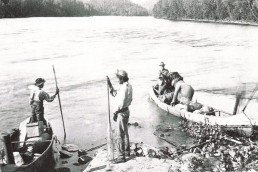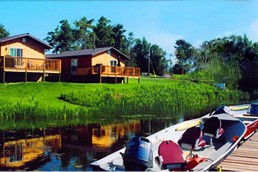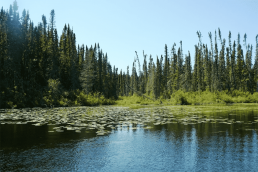Rumors continue to persist among the Ojibwa Indians of Ontario that Dr. Cook’s world-record brook trout—a 14 1/2-pound monster—was really caught by Andrew Lexis, his native guide. At that time, native guides weren’t allowed to make claim to such a prize. True or not, there is no doubt that a 14 1/2-pound fish was caught by a member of the Cook party in 1914 when they fished the Nipigon River near Hamilton Pool.
During the early 1980s, I possessed the skin of that trophy for nine years. It was a half-skin mounted on a piece of birch bark framed with willow. Eventually, when asked, I returned the trophy to the Department of Tourism in Thunder Bay, Ontario. The Nipigon River was a treasure, one nearly completely destroyed to produce water-powered electricity. Yet, today the heart and soul of this mighty river still beats.
It was mid-August in 1938 when I was introduced to the Nipigon. My father Don had decided it was time for his son to step up and experience the river via a float trip. It began at Virgin Falls, the exact spot where my dad created the Muddler fly in 1936. We would float the entire river down to a takeout landing below Split Rock Rapids, a total of 38 miles. Armed with a 7 1/2-foot bamboo fly rod, I would land numerous brook trout, with the largest being a 6-pound beauty.
In August 2013 I went back with Ray Dupuis, Sr. from the town of Nipigon. He was one of the best brook trout anglers I know. Along with “Bobber” Anne, we returned to Virgin Falls. It had been 75 years since I last saw these falls, and much had changed. I saw a mere 8-foot drop that was noted midstream between three blocks of fast surface water. The east bank eddy where dad had first tested the Muddler fly was buried under 14 feet of water now. Even so, the three of us did take brookies, nine in all, up to 7 pounds.
However, it was day two when we returned to a place called the “Overflow,” an area that gladdened my heart. The Overflow lays 15 miles to the west of Virgin Falls. At one time it was only a tiny creek flowing out of Lake Nipigon’s south bay down through a lake called Emma to then enter the main river at a rapids called White Chutes. Today, it’s a 30-yard channel of fast water that covers a two-block stretch before it quiets down in Lake Hanna.
During five hours at the Overflow, our party managed to hook and land 18 brookies. Regulations at this spot require anglers to use barbless hooks and release all fish. Several of our fish carried scars of being caught before while two other fish carried tags implanted when they were caught earlier.
In all, Anne, Ray and I caught and released nine brookies over 5 1/2 pounds at the Overflow.
The Pine Portage dam project was a monster that killed much of the natural river environment south of Lake Nipigon. It killed famous structures such as Victoria Falls, Miner Rapids and Hamilton Pool. Hamilton Pool was the spot that Prince Edward of Wales said was “the most beautiful of any he’d visited on earth.”
Pine Rapids is where I was rewarded with my first big brookie. To a child of 6, it was a monster. Once my dad and I had run Pine Rapids, he suggested our native guides portage back up above and make the run over again. I would be the only angler in the canoe. I connected right where my father had missed a large trout on run one.
Pine Rapids was also the river run where I learned to slip a river. Slipping is a method of boat control where guide face their canoes into a current while paddling forward, yet slipping backward—it’s the best method of boat control used to run the rivers. The boat, or canoe in this incident, slips downstream even though paddles strike forward. The angler is able to cast shoreline, allowing his lure to present a downstream manner. Presenting a lure or bait in this manner is a natural food presentation. I brought this technique with me once I moved, as slipping is deadly on all river species.
There are other signs the Nipigon River still lives: At Split Rock below Pine Portage, there’s enough white water to hold brook trout. At Parmachene Bridge, four miles down from the Alexander Dam, there are trout. Alexander is the lower dam on Nipigon continuing to hold large brook trout. It was here where I guided Ted Williams, the Red Sox Baseball Hall of Famer, while my dad took the duty of helping Joe Brooks of Outdoor Life land a near 6-pound brookie. Today, that area continues to hold significant trophy trout.
The Nipigon may continue to strengthen as White Chutes, Rabbit Rapids, Hamilton Pool, and, of course, Virgin Falls, are restored to their original wilderness beauty. Maybe even the natives may return to their original Parmachene Reserve on the lower Nipigon near the place of my youth, Lake Helen.
Until next time, this is the Ol’ Man Dan Gapen Sr. hoping you savor, relax and cherish our great outdoors. It’s yours to protect for future generations.
MWO
SHARE THIS POST
You may also like...
Did you enjoy this post?
You can be among the first to get the latest info on where to go, what to use and how to use it!
Dan Gapen
Considered one of the world’s leading river anglers, Dan Gapen, Sr. has shared his knowledge with MidWest Outdoors readers and viewers for more than 40 years. He is a member of all three Fishing Halls of Fame—International, National Freshwater, and Minnesota. He has an immense grasp of the world’s fisheries. He may be contacted at 877-623-2099.
@TheGapenCompany.



